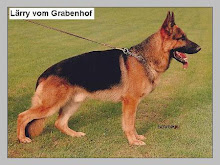Off-Leash Training (1)
For those of you with dogs that are trained to heel accordingly, you are ready to make the transition into off-leash training.
What You Will Need
You will need two pieces of rope, five feet in length each. One of the pieces of rope should be strong and preferably made of nylon. The nylon line should be about the same thickness as a regular kite string. The second piece of rope should actually be a five-foot length of ten-pound test salt water fishing line.
The length of nylon line will be referred to as the “B” line, while the fishing line will be called the “A” line. You will begin by using the “B” line, so you may put away the “A” line for later use.
Tie one end of the “B” line to the ring of the snap on the leash. It must be tied through the ring – rather than the snap – to prevent the line from coming loose. Make sure the line is tied securely. Next, tie the other end of the “B” line on the dog’s training collar, making sure that you tie it onto the same ring that the leash snaps onto. Then, snap the leash onto the collar in the normal manner.
You will notice that you are dragging a loop of line on the ground and either you or your dog will be getting your feet all tangle up, so pick up the “B” line slack and – using a clothespin – attach the “B” line excess right to the leash. This will keep it up and out of the way until you are ready to use it.
The first five minutes of your training period should be just as normal as always. Review all obedience commands so that your dog will be in the proper frame of mind for the upcoming lesson. The second five minutes of the training period should consist of nothing but heeling exercises. Do not go more than five feet in any single direction without either stopping, making a right turn, left turn, or about turn.
Do it fast and smartly so that your pet is performing like a real professional. Then stop and give him praise and a pat on the head. While he is preoccupied with the praise, unsnap the leash, in a nonchalant way, wrapping it into your right hand. One end of the “B” line is still attached to the ring of the leash and the other end to the ring of the training collar.
Put away the clothespin and prepare for a few more quick start-stop heeling exercises. Keep slack in the “B” line and do not allow the line to tighten. If your dog suddenly senses this new feeling of freedom and decides to goof off, he will be in for quite a surprise. Nylon does not break easily and a properly timed correction will produce a sudden revelation to your dog. He will discover that just because the leash is absent, the requirement for obedience is still there, and so is the correction for disobedience as well as the praise for a job well done.
Heel your dog back and forth, making right turns, left turns, about turns, and sudden stops while only the “B” line connects you to your dog. Just before your fifteen-minute training period is up, give your dog praise and snap the leash back on. Finish off the session with a bit more on-leash heel work.
For the next two weeks, you should alternate between working your dog on-leash and using the “B” line. Alternate back and forth, so that your dog won’t be aware of which of the two he is attached to, and doesn’t care either. Working with the “B” line can be a bit awkward and you’ll find that it gets in the way once in a while, especially on the recall exercise. But this transition is important so be patient.
Subscribe to:
Post Comments (Atom)


No comments:
Post a Comment